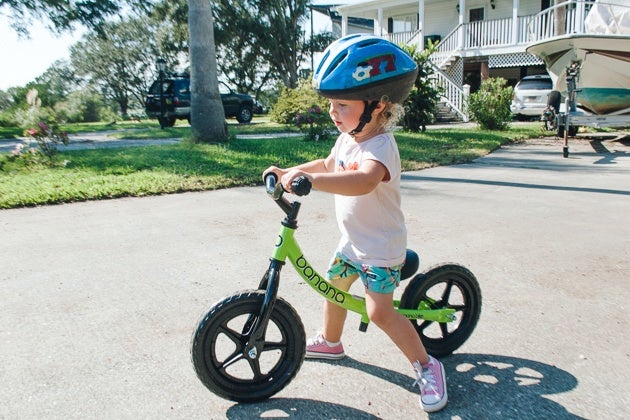Training bicycles, such as a balance bicycle, run bicycle, and no-pedal bicycle, come in handy for kids who may practice balance and steering. It lacks a powertrain, chain, gears, gear shifters, derailleurs, a freewheel, and no foot pedals. For kids, a balance bike is the safest option; they typically just hold the bike and ride without guidance.
Benefits of Using a Balance Bicycle
Convenience for Parents
Balance bicycles can be just the trick parents have been looking for. It reeks of convenience as there is no need for parents to run behind them during their learning process.
Learning the Art of Balance
Kids learn to balance their weight. A balance bicycle teaches kids how to master the trickiest aspect of bicycling first—balancing! Although you can add training wheels to a regular bike, this won’t help them learn how to balance properly.
Developing Core Strength and Leg Muscles
A balance bike encourages kids to ride a self-powered bike rather than utilising pedals, which need significantly more muscle and intricate technique. Furthermore, balancing bikes are propelled by the simple act of pushing with the feet. Therefore, much younger kids can utilise them.
How to Choose the Right Balancing Bike?
In contrast to a pedal cycle, choosing the correct balance bike may appear straightforward. After all, they have fewer moving parts, seem simple to use, are compact, and are far less expensive than regular kids’ pedal bikes. The factors that need consideration while choosing the most suitable balance bicycle are listed below.
Bike Size
The size of the bike is the most important factor when purchasing a balance bicycle. The bike must suit your child now and not in six months. So, don’t think of it as a pair of shoes. Buying your child a bike that is either too big or too tiny might make them feel awkward and steal their enjoyment. Such a negative association can reduce your kid’s interest in riding and exploring the great outdoors. The most common balance bicycle sizes, measured by the diameter of the wheels, are 12, 14, or 18 inches.
Contact Points
Find a saddle that is padded rather than one made of hard plastic. Make sure the fabric is strong and unlikely to tear easily. Children should not use plastic for gripping; look for soft rubber instead. Plastic grips are less comfortable and more slippery than rubber grips. Plastic is solely used by businesses to reduce costs.
Weight
If the bike is lightweight, your youngster should be able to push it easily. Children’s bikes frequently have steel, wood, aluminium alloy, or plastic frames. The best balance bike material is aluminium alloy since it is rust-proof and much lighter than steel.
Brakes
There are balance bicycles with no brakes, just a rear brake, and both front and back brakes. Search for V brakes rather than side-pull brakes. Your youngster will be able to stop safely, thanks to V brakes, which are far more powerful than side-pull brakes.
Seat Height
Balance bicycle seats start at 30 cm and can rise to adult-sized bikes, which measure more than 90 cm. Get your child to sit over the bike to determine if they can handle it. If not, measure their inseam and add 2 to 3 centimetres to the seat.
Final Thoughts
Balance bicycles are specifically made for learning to ride a bike, which requires exceptional balance and coordination. Your child will soon be self-assuredly peddling and appreciating the many health benefits cycling offers.
Kids quickly develop a liking for balancing bikes. They’re very entertaining and easy to use. Children often seek to emulate older children and adults because they look up to them. They won’t want to get off of their balancing bike since it will make them feel more mature and serious.




























